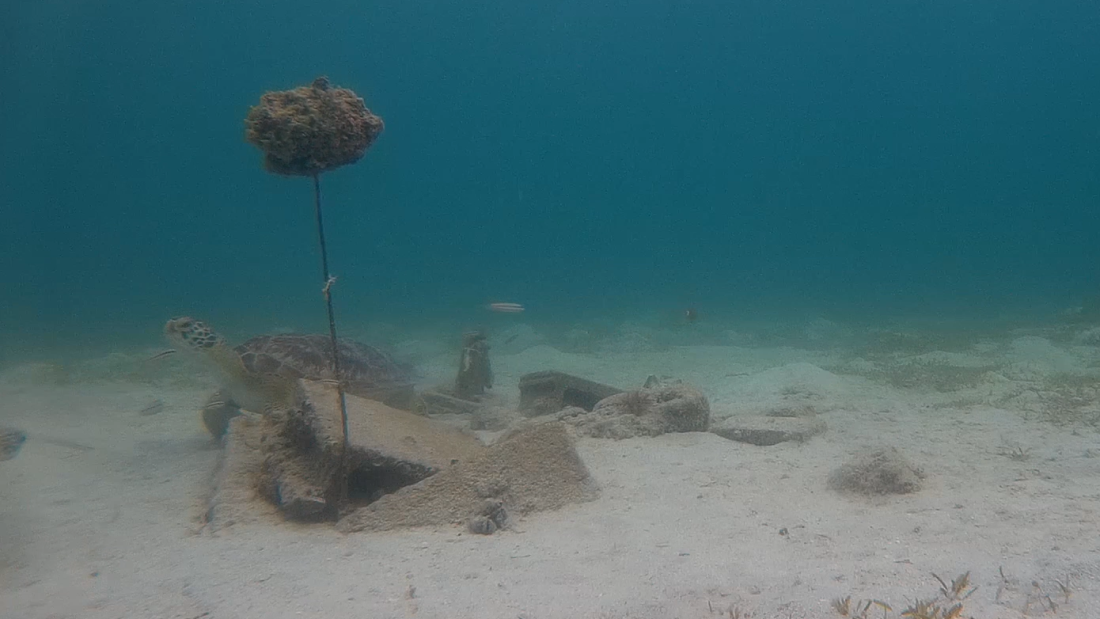A cleaning station for turtles in the waters off the US Virgin Islands recently turned up three fish species that weren’t known to clean turtles. The interaction is a kind of symbiotic relationship as both the hungry fish and the grubby turtles benefit from the collaboration, but there’s growing concern it could also be a hotspot for the spread of a herpes-like disease.
The three fish that hadn’t before been documented as turtle cleaners were Juvenile French angelfish, Pomacanthus paru, juvenile Queen angelfish, Holacanthus ciliaris, and slippery dick wrasses, Halichoeres bivittatus. There appeared to be a natural division of labor as the angelfish cleaned mainly the head, carapace, and plastron, while the wrasses nibbled away at the soft parts of the turtle.
Symbiosis and cleaning stations
Turtle cleaning stations are a charming form of symbiosis, but one that can be hard to spot if you don’t happen to be watching when the turtles turn up. For this reason, identifying the fish working as cleaners can aid scientists in finding the stations, which themselves aren’t rare.
“Anywhere you find sea turtles, you’re probably going to be able to find cleaning stations, it’s just being able to locate those spots,” said lead author Jessica Michael of the Coral World Ocean And Reef Initiative to IFLScience. “Sea turtles in general, especially green sea turtles, are very diligent about keeping their shells clean.”
It’s understandable, then, that the scientists were eager to jump on the opportunity to film this particular cleaning station, which was located just off the dock of the University of the Virgin Islands. The station was visited by several green sea turtles, Chelonia mydas, who are known for being particularly shell proud, and subsequent footage revealed how they defend their position with attitude when needed.
“If one turtle was sitting and posturing at the station and another turtle approached, it was more than likely that turtle was going to show antagonistic behavior,” Michael explained. “Either biting at [the first turtle to arrive], or pushing at it and trying to dominate the station and make the other one leave.”
They’ll do what we call the turtle twerk.
Jessica Michael
It’s not just turtles, either, as the study also captured footage of a stingray and large fishes like jacks and barracudas making the most of the fishes’ eagerness to snap up pesky parasites. Cleaning sessions were on average around six minutes long, but one turtle appeared to bask in a 69-minute session, and their intentions are quite clear from the moment they arrive.
“The turtles usually approach the area slowly and assume a posture where they are propped up on all four flippers,” said co-author Dr Paul Jobsis of the University of the Virgin Islands to IFLScience. “That is not their normal position when grazing, which is with their plastron (belly) on the sea floor. Once in this position the fish will approach quickly and start cleaning. Another common activity is ‘rubbing’. The turtles will rub on the rocks, sand, and each other to keep themselves clean.”

The turtles were also observed self-cleaning by either rubbing against rocks or the rope in this photo.
Screengrab courtesy of Jessica Michael, Paul Jobsis
Why do turtles visit cleaning stations?
Michael also works with captive turtles at Coral World where one of her responsibilities is cleaning their shells. Without a natural cleaning station, it helps their residents stay clean with the aid of a scrubbing brush, and the turtles seem eager to get stuck in.
“They’ll do what we call the turtle twerk,” she said. “They kind of drop their back flippers posture a little bit, and then they just twist their butt back and forth. So, it’s like a turtle twerk. They seem to really enjoy that. You don’t want to run the risk of [using] anthropomorphizing words, but it is something that they do seem to like.”
It all makes sense when you remember what’s inside a turtle’s shell.
Keeping clean can keep turtles healthy, but there is some concern that the fish nibbling on their bodies may increase the transmission of diseases like fibropapillomatosis, which is a form of herpes that causes tumors. As such, gathering data on the role of these cleaner fish can help scientists to study both the ecology of marine ecosystems, and the health of green sea turtles in the Caribbean.
“Ecosystems and food webs are complex and dependent on many species,” concluded Jobsis. “Green sea turtles need a healthy ecosystem that can support the many species needed for them to thrive.”
The study is published in the journal Marine Biodiversity.
Source Link: Who Works At The Turtle Carwash? Videos Reveal Three New Cleaner Species